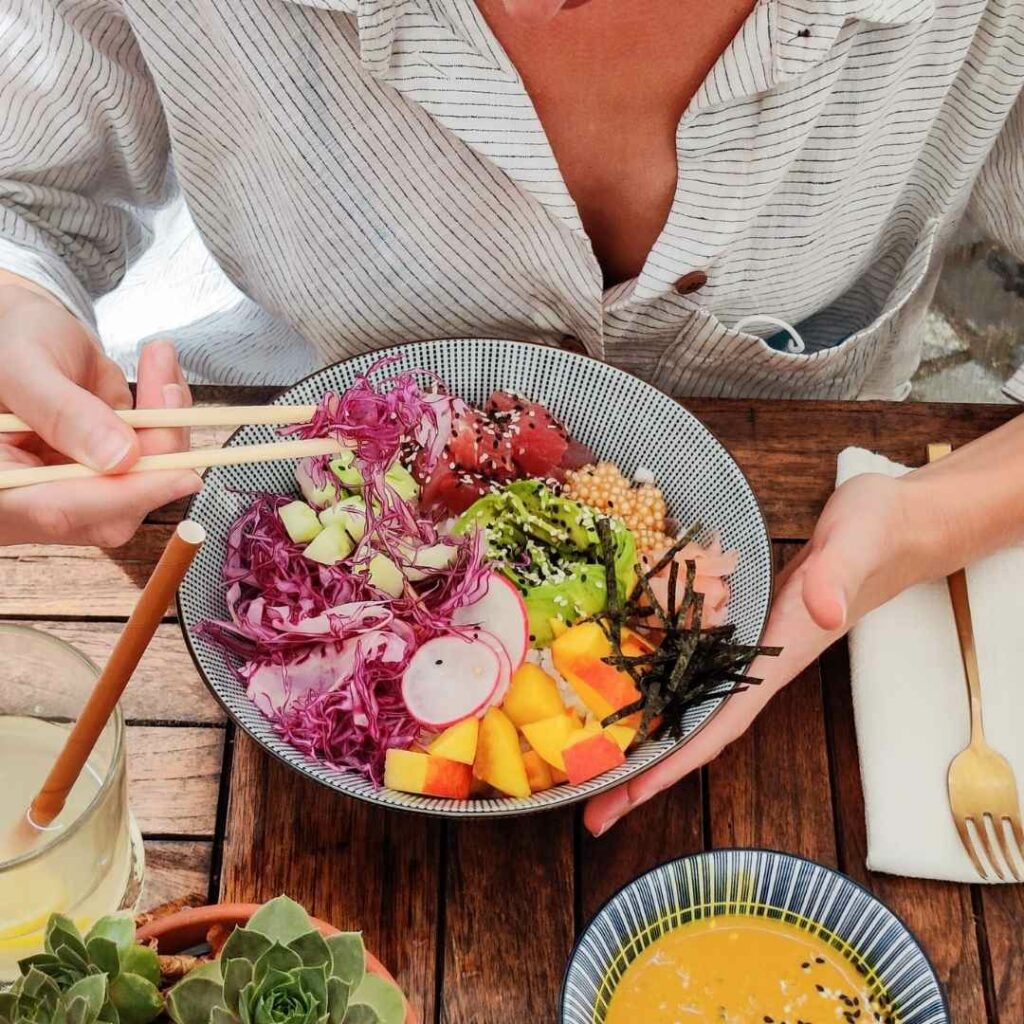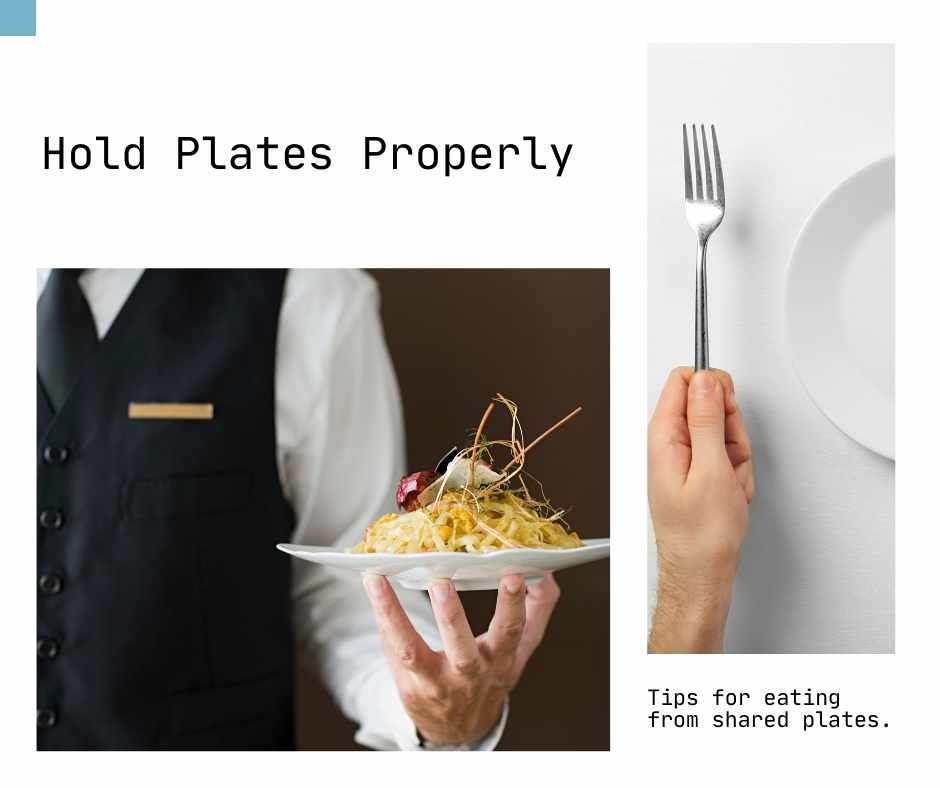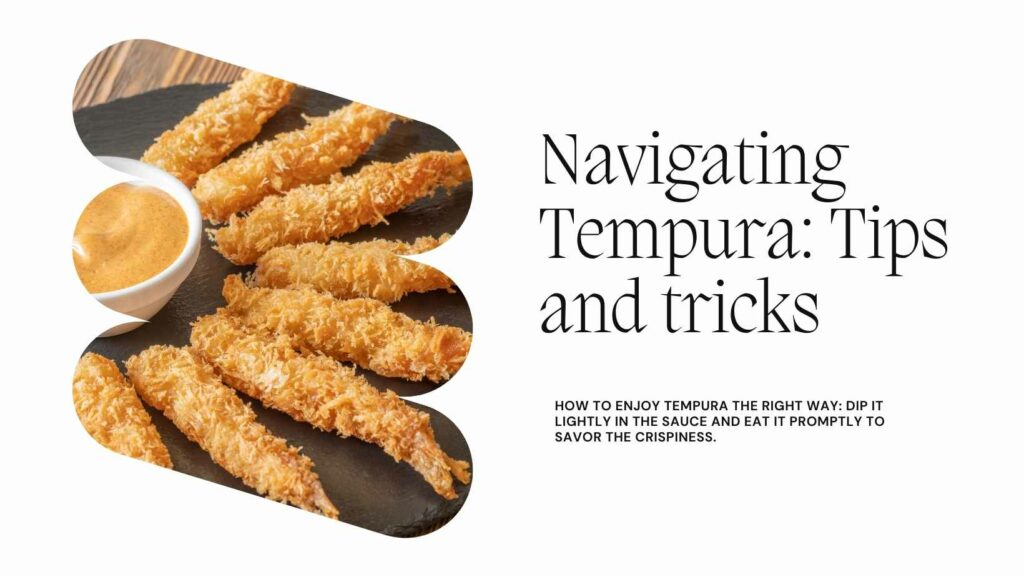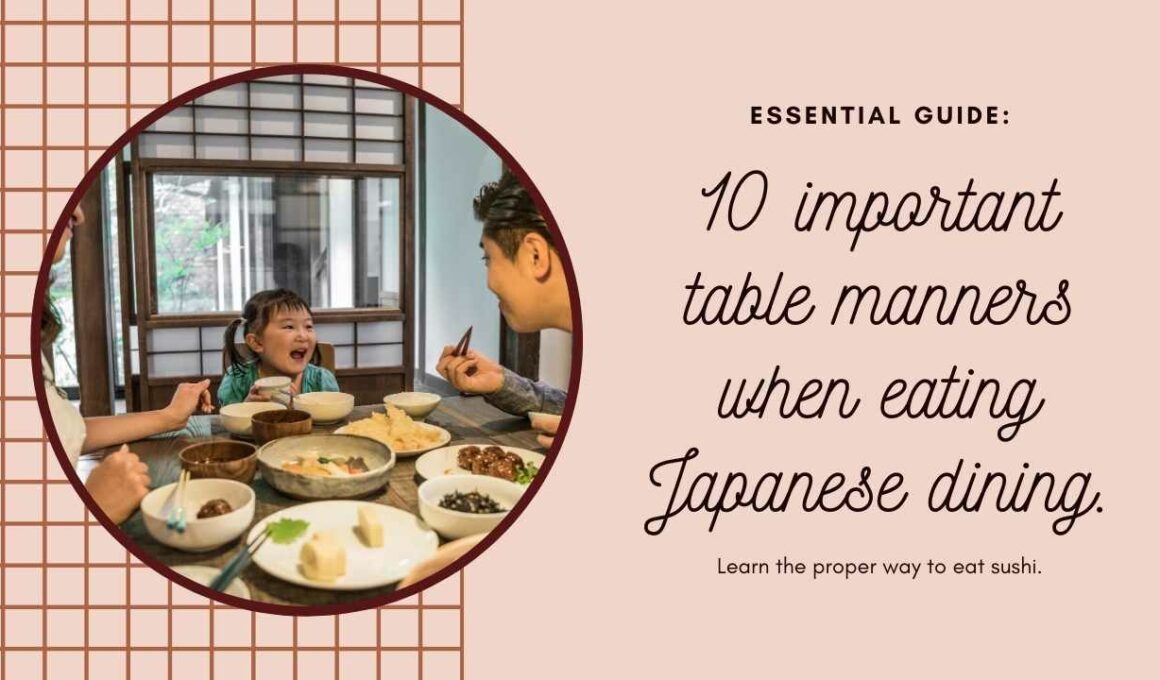Dine Like a Local: 10 Must-Know Japanese dining Eating Etiquette Tips in 2024

1. Table Manners: Some Japanese restaurants have low tables and cushions on tatami floors; adapt to the seating style.

Japanese restaurants can be a bit different from what you’re used to, especially when it comes to where and how you sit. Here’s a quick guide to help you fit right in:
- Getting Comfy: Some places have low tables with cushions on tatami floors. No need to panic; just sit comfortably with your legs crossed or folded beneath you.
- Shoe Etiquette: Before stepping onto the tatami area, remove your shoes. Most places provide slippers to wear inside. If you need to use the restroom, switch back to your own shoes.
- The Right Posture: Forget about chairs; here, it’s all about sitting on the floor. Don’t worry; there’s no need for fancy yoga poses. Just find a position that feels comfy for you.
- Getting Up Gracefully: When it’s time to leave, stand up gracefully. Avoid putting weight on the table for support; use your legs instead.
- Shoe Swap: Remember to switch back to your outdoor shoes before leaving. It’s a small detail, but it makes a big difference.
With these simple tips, you’ll be navigating those low tables and tatami floors like a pro in no time!
“If you are looking for the best hotel and flight deals for your next vacation, then we recommend booking your bundled flight and hotel through hotwire.com.“
2. Chopstick Etiquette: Never raise your food above your mouth; maintain a reasonable height for your chopsticks.

Chopsticks are more than just eating tools in Japan; they’re an art form. To make the most of your dining experience, here’s a quick guide to chopstick height etiquette:
- Mind the Height: When using chopsticks, keep them at a reasonable height, never raising your food above your mouth. This ensures a respectful and graceful dining experience.
- Balancing Act: Treat your chopsticks like an extension of your hand, using them with a delicate touch. Avoid gripping or holding them too tightly; let them effortlessly balance your food.
- Control Your Chopsticks: Practice control to avoid dropping or splattering food. This not only maintains cleanliness but also shows your respect for the art of dining.
- No Drumming, Please: Resist the urge to tap or drum with your chopsticks, as it’s considered impolite. Focus on savoring your meal with quiet enjoyment.
By mastering these simple chopstick height guidelines, you’ll add an extra touch of charm to your dining etiquette in Japan.
3. Shared Dishes: Avoid sticking chopsticks upright in shared dishes, as it’s considered bad manners in Japan.

when sharing a meal, using chopsticks comes with some unwritten rules that go beyond merely picking up your favorite dish. One essential tip to keep in mind is to avoid sticking your chopsticks upright in shared dishes. Here’s why:
- Symbolic Respect: Sticking chopsticks upright in a dish is reminiscent of a ritual performed at funerals. Doing so during a meal is considered inappropriate and disrespectful.
- Cultural Sensitivity: In Japanese culture, meals are seen as a time for joy and togetherness. Sticking chopsticks upright contradicts this sentiment, as the gesture resembles a ritual associated with more somber occasions.
- Alternative Practices: Instead of leaving your chopsticks standing, consider laying them across the dish or using the provided chopstick rests. This showcases your understanding of the cultural nuances and your respect for the meal.
By being mindful of this chopstick etiquette, you not only avoid cultural faux pas but also contribute to a more harmonious and respectful dining experience.
4. Soup Etiquette: Use chopsticks to eat solid components in soup; slurping is acceptable and signifies enjoyment.

When diving into a bowl of Japanese soup, there’s more to it than just sipping quietly. Embracing the local etiquette enhances your dining experience. Here’s the lowdown on Japanese soup manners:
- Chopstick Precision: While chopsticks are generally used for solid components in the soup, it’s essential to avoid fishing for liquid with them. Lift out the solid ingredients with your chopsticks and enjoy them separately.
- Slurping Sensation: Unlike in some Western cultures, slurping your soup in Japan is not only acceptable but often encouraged. It signifies your appreciation for the meal and the chef’s efforts. So, feel free to make some noise while savoring your soup.
- Maintaining Harmony: The goal is to enjoy the flavors without creating a mess. Use chopsticks judiciously, and feel free to slurp quietly, contributing to the overall atmosphere of contentment in the dining setting.
By adhering to these simple soup etiquette tips, you’ll not only navigate your meal gracefully but also immerse yourself in the authentic dining experience Japan has to offer.
5. Hold Plates Properly: When eating from shared plates, rice, or soup bowls, hold them with one hand while eating

When you’re eating from shared plates or bowls in Japan, it’s like learning a special way to hold them. Imagine it as a little dance – you use one hand to balance and enjoy your food. Here’s the lowdown in super simple terms:
Single-Hand Superstar: When you eat from shared plates, rice bowls, or soup bowls, try holding them with just one hand. It’s like showing off your cool moves at the dining table.
Balance Magic: Holding the plate with one hand isn’t just about being fancy; it’s about finding the perfect balance. You’re not wrestling with the dish – you’re gracefully enjoying what’s on it.
Give it a Go: This might feel a bit different at first, but trust me, it adds a nice touch to your dining adventure. You’ll see – it’s not just about the food; it’s about making your meal feel like a special experience.
So, next time you’re at a Japanese table, remember the cool trick of holding plates with one hand. It’s not hard – it’s fun!
6. Navigating Raw Fish: When enjoying sushi, dip only the fish (not the rice) into soy sauce, and try not to mix wasabi directly into the soy sauce dish.

Sushi – it’s like a flavorful work of art, and knowing how to navigate it adds a special touch to your dining experience. Here’s a detailed guide to the art of handling raw fish, whether you’re a sushi pro or diving into this world for the first time:
Soy Sauce Splash: When it comes to soy sauce, imagine it as the ocean and your sushi as a boat. You want just the right amount of splash!
- Fish Dive: Dip only the fish part of your sushi into the soy sauce, not the rice. Why? Because the rice is like the base of your sushi masterpiece, and it might crumble if it takes a soy sauce plunge.
- Dainty Dip: No need for a soy sauce dive. A delicate touch is the key. A brief, gentle dip – let the fish feel the ocean breeze without drowning.
Avoid the Wasabi Sea: Now, let’s talk about wasabi – that little green gem that adds a kick to your sushi journey.
- Solo Show: Wasabi deserves its own spotlight. Avoid mixing it directly into the soy sauce dish. It’s like letting each flavor have its moment on the culinary stage.
- Savor Separately: Place a small amount of wasabi directly on the sushi if you want to experience its unique taste. This way, you savor the spicy magic without diluting it in the soy sea.
Culinary Caution: Handling sushi is an art, and every brushstroke matters. Here are some finer points to keep in mind:
- Minimal Mixing: Sushi is a delicate dance of flavors. Mixing too much soy sauce or wasabi can overpower the subtle tastes. Keep it minimal, like adding just a hint of color to a masterpiece.
- Respect the Chef’s Creation: If the chef has already brushed soy sauce onto your sushi, there’s no need for an additional dip. It’s like saying, “I trust your artistry, maestro!”
Dive into the Experience: Eating sushi is not just a meal; it’s a journey.
- Savor the Moment: Take a moment to appreciate the colors, the textures, and the flavors. It’s not just about filling your stomach; it’s about feeding your senses.
- Experiment Gently: If you’re new to sushi, don’t be afraid to experiment. Try different combinations, and find what suits your taste buds. It’s a personalized adventure on a plate.
So, when you’re navigating the world of raw fish, remember – it’s not just about the sushi; it’s about the experience, the art, and the joy of culinary exploration.
7. Respectful Pouring: If pouring drinks for others, hold the bottle with two hands as a sign of respect.
In Japan, pouring drinks is more than just a practical task; it’s a meaningful gesture of respect and connection. Let’s break down the simplicity and elegance of this act:
Two-Handed Grace: When you’re the one pouring, use both hands to hold the bottle. It’s a way of showing that this act is not just routine; it’s a moment of respect and consideration. Look into the eyes of the person you’re serving, creating a shared connection.
Symbolism in Every Drop: Pouring a drink isn’t just about the liquid; it’s a symbol of moderation and thoughtfulness. Pour just enough to share the joy without overwhelming. Always pour for others before tending to your own glass, reflecting a selfless attitude.
Sharing and Bonding: Pouring drinks is a communal experience in Japan. It’s a time to celebrate togetherness. When someone pours for you, receive it with both hands, reciprocating the respect. The act of clinking glasses is a shared joy, reinforcing social bonds.
Adapting to Occasions: Knowing when and how to pour adds sophistication to your dining experience. In formal settings, a pourer might kneel, while in casual situations, standing is acceptable. Pay attention to subtle cues, like covering the glass, indicating when someone has had enough.
In Japanese dining, pouring drinks isn’t just a routine; it’s a cultural expression. It’s a language of respect, shared moments, and the subtle dance of social harmony. So, the next time you pour, let it be more than just liquid in a glass. Let it be a sincere gesture that speaks volumes about your appreciation for togetherness.
8. Silent Enjoyment: In Japan, it’s common to eat quietly and avoid making loud noises while chewing; embrace the cultural practice of silent enjoyment.
In the heart of Japanese dining etiquette lies a gesture that transcends mere practicality – the act of pouring drinks with respect. It’s not just about quenching thirst; it’s a cultural expression, a way of saying more than words convey. Let’s explore the nuances of this gesture:
Two-Handed Pouring: A Symbol of Respect Pouring a drink in Japan involves more than just tipping a bottle. It’s a gesture steeped in tradition and respect. When you find yourself in the role of the pourer, grasp the bottle with both hands. This signifies not just the act of offering refreshment but a deep acknowledgment of the person you’re serving.
Building Connections Through Pouring: In Japanese culture, sharing a drink is often a communal experience. By pouring for others with both hands, you’re building a connection, recognizing the shared moment of enjoyment. It goes beyond the liquid in the cup; it’s about sharing a part of yourself with those around you.
Expressing Consideration: The two-handed pour is a gesture of consideration. It communicates that you’re mindful of the other person’s experience, ensuring they receive the right amount without spillage. It’s a small act that reflects thoughtfulness and care.
Rituals in Social Settings: This pouring tradition extends to various social settings – from casual gatherings to formal dinners. Whether you’re with friends, colleagues, or new acquaintances, the two-handed pour remains a constant, creating a sense of unity and shared enjoyment.
Preserving Tradition in Modern Times: While Japan has embraced modernity, the act of respectful pouring persists. It’s a link to the past, a reminder of the cultural values that continue to shape everyday interactions. In a rapidly changing world, this gesture serves as a bridge between tradition and contemporary living.
So, the next time you find yourself holding a bottle in a Japanese dining setting, let your pour be more than just a transfer of liquid. Let it be a language of respect, connection, and the rich tapestry of Japanese culture.
9. Handling Oshibori (Wet Towels): Use the Oshibori provided before meals to clean your hands, not your face. Folding it neatly after use shows appreciation.
Imagine you’re about to start a delicious meal in Japan, and before you dive into the flavors, a wet towel, known as Oshibori, is handed to you. This isn’t just about wiping your hands – it’s a dance of manners.
Purposeful Purity: Cleaning Hands, Not Faces The towel is there to freshen up your hands, not your face. It’s a polite way to make sure you feel comfortable before your meal. Japanese folks take personal cleanliness seriously, and the Oshibori is a part of that.
The Ritual of Unfolding: An Act of Appreciation When you unfold the towel, take your time. It’s like saying “thank you” to your host for their thoughtful gesture. It’s a small thing but shows you recognize the effort to make your dining experience special.
Gentle Dabbing, Not Rubbing: When you use the Oshibori, don’t rub vigorously. A gentle pat is all you need. This keeps things tidy and ensures the towel does its job without making a big show.
A Moment of Mindfulness: Using the Oshibori isn’t just about cleaning; it’s a moment to pause and get ready for your meal. It’s a small, quiet time that marks the shift from the outside world to the delightful experience ahead.
Folding Gracefully: A Gesture of Gratitude: After you’ve freshened up, folding the towel back is a simple but meaningful act. A neatly folded towel says, “I appreciate the care you’ve taken to provide this, and I acknowledge it with the way I handle it.”
A Tapestry of Tradition: Oshibori etiquette is like a thread woven into Japan’s rich cultural tapestry. It might seem like a small thing, but it reflects the importance of cleanliness, gratitude, and the art of mindful gestures. So, as you use that seemingly ordinary wet towel, remember you’re participating in the harmony of the Japanese dining experience.
10. Navigating Tempura: When enjoying tempura, dip it lightly in the provided sauce, and eat it promptly to savor the crispiness.

Tempura, with its golden crispiness and delicate flavors, is a culinary experience that demands a touch of finesse. Here’s your guide on navigating the world of tempura in Japanese dining.
Dainty Dipping: A Gentle Bath for Tempura When it comes to the accompanying sauce, less is more. Gently dip your tempura, allowing only a light coating. The intention is to enhance the flavor, not overpower it. The delicate dance of textures should be preserved.
Prompt Pleasure: Savoring the Freshness The charm of tempura lies in its immediate consumption. The batter achieves the pinnacle of crispiness, and the ingredients retain their tender juiciness when eaten promptly. Delaying the enjoyment might result in missing the perfect harmony of textures.
Crispy Connection: A Symphony of Tastes Tempura is not just a dish; it’s a symphony of flavors. The light, crunchy exterior meets the succulent interior, creating a harmonious balance. Each bite should be a celebration of this delicate interplay of tastes and textures.
Mindful Munching: Focused Enjoyment When indulging in tempura, let it take the spotlight on your palate. Avoid pairing it with strongly flavored dishes to appreciate its subtleties fully. This mindful approach ensures you relish the distinct taste of each tempura piece.
Silent Symphony: savoring food in silence is a cultural practice. As you bite into tempura, appreciate the subtle crunch without unnecessary noise. Let each bite become a moment of silent pleasure, respecting the culinary craftsmanship.
Respectful Relishing: An Artful Affair Tempura transcends being merely a dish; it’s an art form. Take your time, acknowledging the culinary craftsmanship involved. Relish each bite as if you are partaking in a timeless tradition, appreciating the simplicity and artistry within every piece of tempura.
Crispy Connection to Tradition: A Culinary Heritage Tempura carries the weight of tradition. By savoring it with a delicate touch and mindful approach, you’re not just enjoying a meal but also honoring the enduring tradition of finding beauty in simplicity and savoring the artistry in every bite.
How much did you like Our detailed 10 Important Table Manners When Eating Japanese dining? Review Also, please share these Blogs with your friends on social media.
Recommended
- Travel Hacks
- 12-Ways to Keep Kids Entertained
- Travel Tips for Single Parents
- Top travel tips for seniors

Meet David Hoper, a passionate travel Blog writer with 7+ years of experience in travel content. Through his exemplary storytelling and engaging narratives, he shares his experiences and brings destinations to life. With a keen eye for detail and a love for exploration, he has cultivated a diverse portfolio of travel blogs that inspire and inform readers worldwide.








